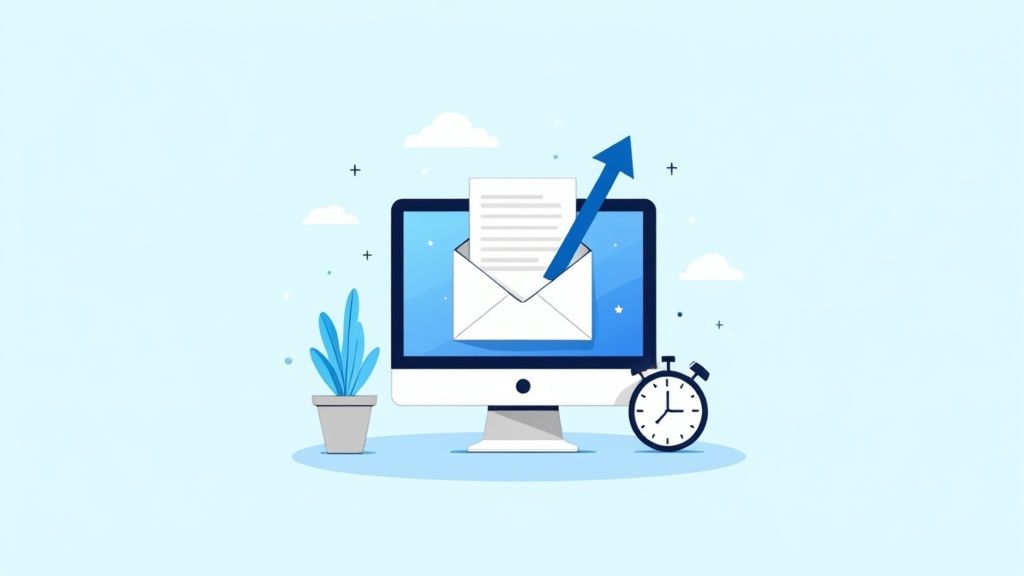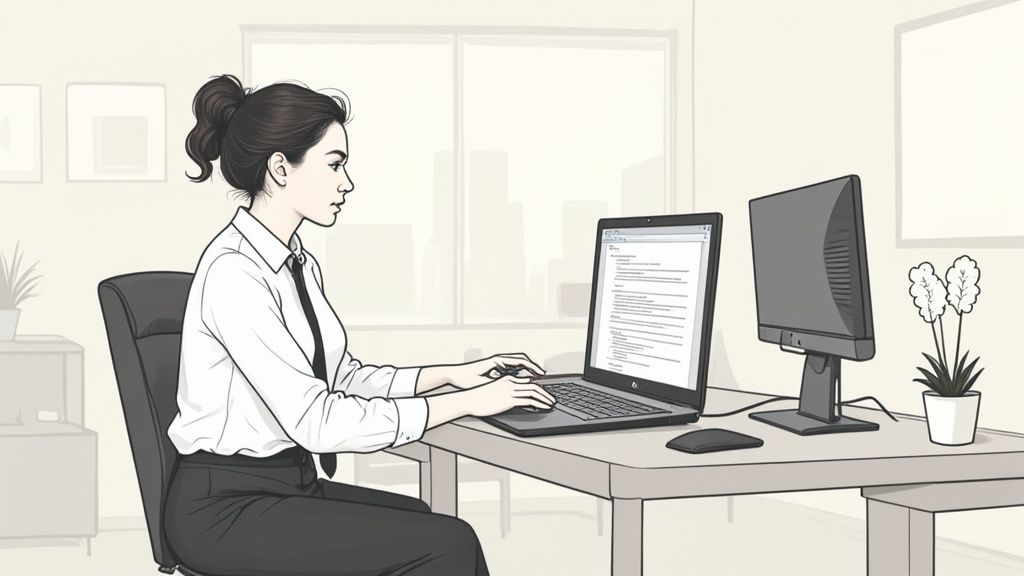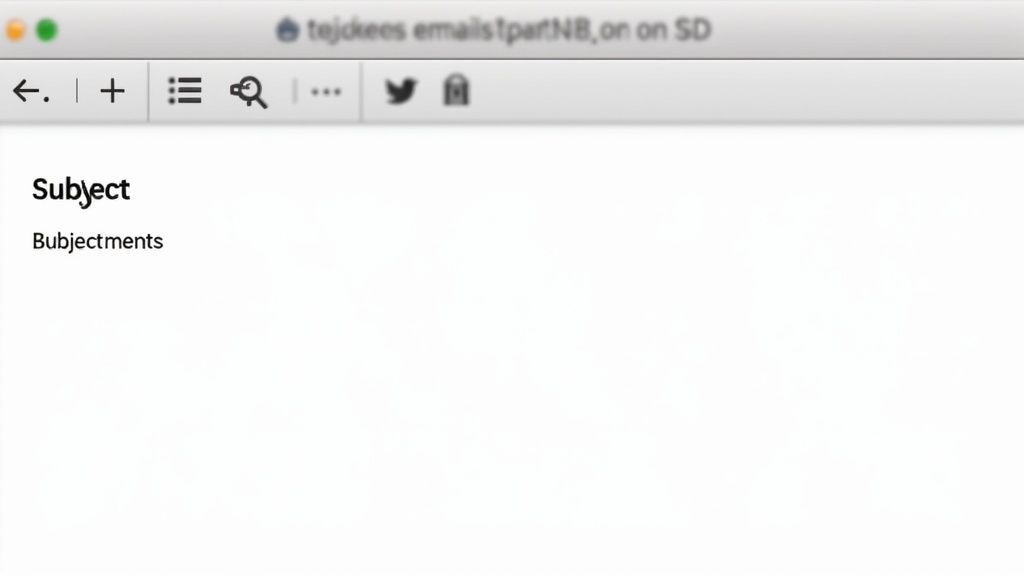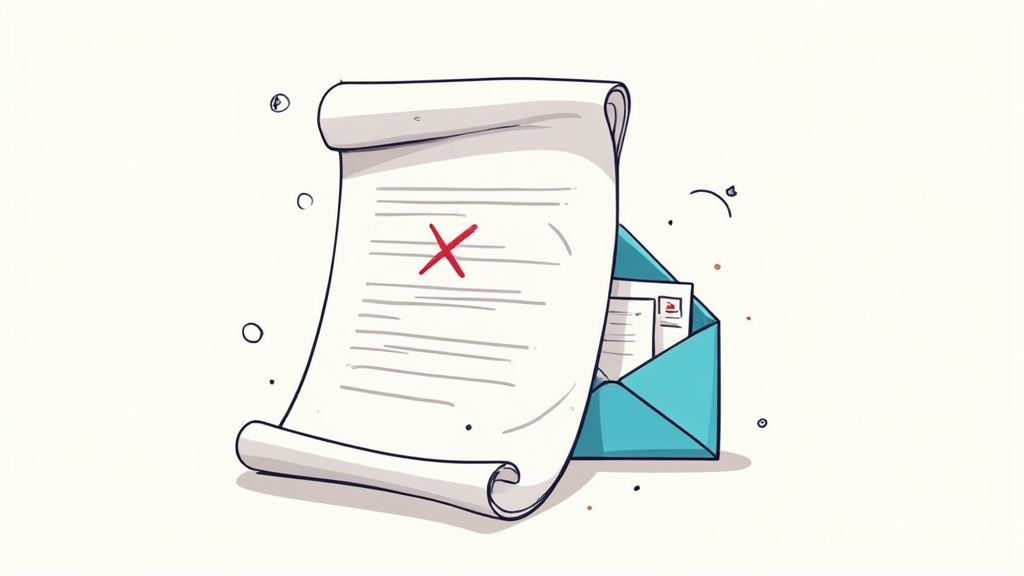
Application Follow Up Email: Your Complete Success Guide
Published
Why Your Application Follow Up Email Makes All The Difference

In today's competitive job market, your resume is often one of many. Standing out is essential, and a well-crafted application follow-up email can be your key to success. This simple message can transform your status from just another applicant to a memorable candidate.
The Psychology of the Follow Up
Hiring managers are often overwhelmed with applications. Following up demonstrates initiative, attention to detail, and genuine interest. These are valuable qualities employers seek. This proactive approach shows you're actively pursuing the opportunity and respect the hiring manager's time.
Imagine two equally qualified candidates: one applies and waits; the other follows up, reiterating their interest and highlighting key skills. The follow-up creates a stronger impression, transforming the candidate from a name on a resume into a proactive individual.
Personalized follow-up emails can significantly improve response rates. Research from Woodpecker in 2025 found that a single follow-up increased the average reply rate from 9% to 13%. For experienced users, the rate jumped from 16% to 27%. This demonstrates that a well-crafted follow-up email significantly increases your chances of a response. You might also be interested in learning more about marketing director interviews: How to master your next marketing director interview. Find more detailed statistics here.
Real-World Impact
Conversations with hiring managers and HR professionals reveal a clear pattern: recruiters value thoughtful follow-ups. They provide a chance to reaffirm your interest and showcase your communication skills. In some cases, a single follow-up email has been the deciding factor in landing a dream job.
This highlights the power of this simple yet effective strategy. However, balance is crucial. While follow-ups are appreciated, excessive or poorly written emails can be detrimental. Finding the right timing for maximum impact is an art.
Nailing the Perfect Timing For Maximum Impact
Timing is critical for successful application follow-up emails. Too soon can seem desperate; too late, and you might be forgotten. This section explores optimal timing strategies to maximize your response rate without being overly persistent.
The Waiting Game: Finding the Sweet Spot
The ideal timeframe for your first follow-up email is typically two to five business days after your initial application. This demonstrates genuine interest without overwhelming the hiring manager. However, factors like company size and industry can influence this timing.
For example, fast-paced startups might appreciate a quicker follow-up, while larger corporations may have longer hiring cycles. Consider the application deadline as well.
If a deadline is approaching, a follow-up a few days prior can be beneficial. Reiterating your interest ensures your application stays top-of-mind and shows you are actively engaged.
Best Days and Times to Send: Maximizing Open Rates
While the number of days between contact is important, the specific time of day matters too. Research suggests that mid-week, particularly Tuesday through Thursday, yields higher email open rates.
Avoid Mondays, when inboxes are often overflowing, and Fridays, when people begin thinking about the weekend. Aim to send emails during business hours.
Late morning (10 a.m. to 12 p.m.) and early afternoon (1 p.m. to 3 p.m.) are often good choices. People have settled into their workday and are more likely to be checking emails.
Persistence vs. Annoyance: Striking the Right Balance
Following up is essential, but overdoing it is detrimental. After your initial follow-up, if there's still no response, consider one or two additional follow-ups spaced one or two weeks apart.
Each follow-up should offer new value or information, such as updates on your skills or relevant industry news. Consistent communication makes a difference.
According to Salesgenie, 35-50% of sales are won by the first company to follow up. This translates to job applications: proactive communication can significantly boost your chances.
Handling the Wait: Maintaining Your Sanity
Waiting can be stressful, but patience and professionalism are essential. Use this time productively: network with other professionals, refine your resume, or explore other job opportunities.
This keeps you busy and strengthens your overall job search. Managing the wait effectively demonstrates resilience and helps you maintain a positive mindset.
Writing Follow Up Emails That Actually Get Responses

Crafting a compelling follow-up email after applying for a job is essential for making a lasting impression in a competitive job market. Generic templates are easily recognizable, so your objective should be to write emails that capture a hiring manager's attention. This requires understanding effective communication strategies and personalizing your approach.
Crafting a Subject Line That Gets Opened
Your subject line is your first, and perhaps only, opportunity to make a good first impression. It determines whether your email is opened or ignored. Keep it brief, specific, and directly related to the job you applied for. Instead of a vague subject like "Following Up," consider a more specific option such as "Following Up: Application for Marketing Manager Role."
Personalizing the subject line with the company name or mentioning a previous conversation can significantly improve your open rates. This demonstrates you've invested time in creating a targeted message, not a mass email.
Personalization: The Key to Engagement
The content of your email should be equally personalized. Begin with a professional and friendly greeting, addressing the hiring manager by name. Briefly remind them of your previous interaction, referencing the specific position and the date you applied. This helps them quickly remember your application and sets the context for the rest of your email.
Instead of just repeating your qualifications, explain how your skills and experience match the company's specific requirements. This shows you understand their business and demonstrates genuine interest in the role. For more insights into managing client relationships, explore this article on how to master the art of account management.
Providing Value and a Clear Call to Action
Avoid simply rehashing your resume. Offer something new, such as a recent accomplishment, a relevant industry article, or a unique perspective on a company challenge. Providing value strengthens your candidacy and keeps you at the forefront of the hiring manager’s mind. This reinforces your enthusiasm and showcases your initiative.
Conclude your email with a clear call to action. Reiterate your interest in the position and your availability for an interview. Suggest a specific time frame for a follow-up call or simply inquire about the hiring process updates. This gives the hiring manager a concrete next step and encourages a response.
Follow-Up Email Statistics: The Power of Persistence
Research shows the importance of persistent, personalized follow-up. Studies from Saleshandy and Woodpecker indicate that over 50% of responses occur after the initial email, particularly when follow-ups are personalized. Personalized follow-ups can boost reply rates by up to 20%. Including new, valuable information increases conversions by 15-18%. Explore more detailed statistics here. Remember, your follow-up email aims to re-engage the hiring manager and advance the conversation.
Adapting to Different Cultures and Industries
Recognize that companies and industries have unique cultures. Research the company's culture and industry standards to ensure your tone and style are appropriate. A formal approach may be suitable for a traditional corporation, while a more casual tone might work better for a startup. This attention to detail demonstrates your adaptability and understanding of their environment.
Ready-To-Use Templates That Land Interviews
Tired of staring at a blank screen when trying to craft the perfect follow-up email? We understand the struggle. That's why we've compiled a collection of proven application follow-up email templates designed to get results. This section offers effective frameworks for a variety of scenarios, from the initial follow-up after applying to post-interview check-ins.
First Follow-Up After Applying
This template is your starting point after submitting a job application. It reinforces your interest in the position and highlights your most relevant qualifications.
Subject: Following Up: Application for [Job Title] at [Company Name]
Body:
Dear [Hiring Manager Name],
I hope this email finds you well.
I'm writing to follow up on my application for the [Job Title] position, which I submitted on [Date]. I'm particularly interested in [Company Name]'s work in [Industry/Area]. My skills in [Skill 1] and [Skill 2] closely align with the requirements outlined in the job description.
Thank you for your time and consideration. I look forward to hearing from you soon.
Sincerely,
[Your Name]
Second Follow-Up: Breaking the Silence
If you haven't received a response after a week, this template provides a polite nudge to the hiring manager.
Subject: Checking In: Application for [Job Title] at [Company Name]
Body:
Dear [Hiring Manager Name],
I hope this email finds you well.
I'm following up on my previous email regarding the [Job Title] position. I recently [mention a relevant accomplishment or industry news]. This has further strengthened my interest in contributing to [Company Name]'s mission.
I'm eager to learn more about this opportunity. Please let me know if there’s any further information you need from me.
Sincerely,
[Your Name]
Post-Interview Follow Up
After an interview, sending a thank-you note and reiterating your enthusiasm keeps you at the forefront of the hiring manager’s mind.
Subject: Thank You - Interview for [Job Title] at [Company Name]
Body:
Dear [Interviewer Name],
Thank you for taking the time to speak with me about the [Job Title] opportunity on [Date]. I especially enjoyed our conversation about [Specific Topic Discussed]. Our discussion reinforced my interest in joining the team at [Company Name]. I'm confident that my skills and experience in [Relevant Skill] would allow me to make a meaningful contribution.
Please don't hesitate to reach out if you need anything further from me. I look forward to your response.
Sincerely,
[Your Name]
Internal Position Follow Up
Applying for internal positions often requires a slightly different approach. This template strikes a balance between professionalism and your company culture.
Subject: Following Up: Internal Application for [Job Title]
Body:
Hi [Hiring Manager Name],
I'm writing to follow up on my application for the internal [Job Title] position. I'm excited about the prospect of using my skills in [Skill] in this new role within the team. My experience in [Previous Role/Project] will ensure a smooth transition and enable me to contribute effectively from the start.
Please let me know if you have any questions or require any additional information. I'd welcome the opportunity to discuss this role further with you.
Best,
[Your Name]
Adapting Templates and Maintaining Authenticity
The templates provided here are designed as flexible starting points. Personalization is crucial. Tailor them to reflect your unique situation, emphasizing pertinent skills and experience. For a more effective follow-up strategy, consider incorporating principles from email marketing best practices. Remember, authenticity matters. Let your personality shine through while maintaining a professional tone. Avoid generic language and focus on building genuine connections. By combining these templates with your personal touch, you'll be well on your way to landing interviews and advancing your career.
The following table summarizes these different email types:
Follow-Up Email Templates by Scenario
A comprehensive comparison of different follow-up email templates categorized by specific application scenarios
| Scenario | Template Type | Key Elements | Timing |
|---|---|---|---|
| Applying for a job | Initial follow-up | Reinforce interest, highlight qualifications | After application submission |
| No response after one week | Second follow-up | Polite nudge, mention recent accomplishment | One week after applying |
| After an interview | Thank-you note | Express gratitude, reiterate interest, discuss specific topic | Within 24 hours of interview |
| Applying for an internal position | Internal follow-up | Balance professionalism and company culture, highlight internal experience | After application submission |
This table provides a quick reference for choosing the right template and tailoring it to your specific needs. Remember, a well-crafted follow-up email can be the key to securing your next opportunity.
Critical Mistakes That Kill Your Chances

Even with the best intentions, application follow-up emails can backfire. This section explores common blunders that can turn off hiring managers and land your email in the delete folder. Proper preparation for a job interview can significantly improve your chances of getting hired. A helpful resource on this topic is available for Virtual Assistant Job Interviews.
The Aggression Avalanche: Too Much Too Soon
One of the most common mistakes is being overly aggressive. Repeatedly contacting a hiring manager with multiple emails or phone calls within a short period can make you appear desperate or disrespectful of their time. This can create a negative first impression, ultimately sabotaging your chances.
For example, sending three follow-up emails in a single week can easily overwhelm the recipient. Instead, patiently wait the recommended two to five business days for an initial follow-up.
The Generic Gambit: Impersonal and Uninspired
Another frequent error is sending generic, mass-produced emails. These often lack personalization and fail to demonstrate genuine interest in the specific role or company. Hiring managers can quickly identify these impersonal messages, often leading to immediate dismissal.
Tone Trouble: Entitlement vs. Enthusiasm
The tone of your follow-up email is crucial. Coming across as entitled or demanding can quickly damage your credibility. Phrases like "I demand an update" or "I deserve an interview" create a negative impression.
Instead, maintain a professional and enthusiastic tone. Express genuine interest and highlight relevant skills.
Digital Disasters: Etiquette Errors
Simple digital etiquette mistakes can also derail your application. Using an unprofessional email address, poor formatting, or sending emails outside of business hours reflects poorly on your attention to detail and communication skills. These seemingly small errors can make a significant difference in a competitive job market.
Recovery Routes: Damage Control After a Misstep
If you've already made one of these mistakes, don't panic. Acknowledging the error and sending a sincere apology can sometimes salvage the situation. Follow up with a well-crafted, personalized email that focuses on the value you bring. This demonstrates professionalism and a willingness to learn. However, prevention is always the best strategy. Carefully crafting your follow-up emails with the right tone, timing, and personalization can significantly improve your chances of landing an interview.
Advanced Strategies For Competitive Job Markets
In highly competitive job markets, a standard application follow-up email just won't cut it. You need advanced strategies to rise above the hundreds of other qualified candidates. This section explores tactics to elevate your follow-up game and boost your chances of landing an interview.
Building Momentum with Follow-Up Sequences
A single follow-up email is a good start, but a strategic sequence is far more effective. Think of it as a marketing campaign: you wouldn't send one email and consider it done. Similarly, plan a series of follow-ups, each offering new value or information. This keeps you on the hiring manager's radar without being overly persistent.
For example, your first follow-up email can reiterate your interest and highlight key skills. The second could share a relevant industry article or a recent accomplishment. A third might inquire about the next steps in the hiring process. This demonstrates continued enthusiasm and creates valuable touchpoints.
Leveraging Multiple Communication Channels (Strategically)
While email is the primary communication method, consider using other channels to complement your outreach. Connecting with the hiring manager on LinkedIn can reinforce your interest and provide another avenue for engagement. However, avoid overwhelming them with messages across multiple platforms. Use discretion and maintain professionalism.
For instance, after sending a follow-up email, you might send a brief LinkedIn message referencing your email and expressing continued interest. This reinforces your application without being overwhelming. You might be interested in: How to master a digital marketing career path.
Social Media Intelligence: Research and Relevance
Use social media to your advantage. Research the hiring manager and company culture to personalize your follow-up emails. Look for recent company news or industry events you can reference in your communication. This demonstrates that you’ve done your homework and makes your follow-up more relevant.
For example, if the company recently announced a new product, you could mention it in your email and explain how your skills could contribute to their success. This shows you're actively engaged with their work and makes your follow-up more compelling.
Timing Your Follow-Ups Around Key Events
Timing is critical. Instead of sending generic follow-ups, align them with relevant events. If the company is hosting a webinar or attending a conference, follow up shortly after to reiterate your interest and mention something you learned. This demonstrates engagement and keeps you top-of-mind.
The infographic below illustrates the importance of timely follow-ups:

This infographic visualizes the reply rates for follow-up emails sent at different intervals. A follow-up within three days yields the highest response rate (60%), highlighting the importance of prompt communication. The response rate drops to 30% after seven days and 10% after two weeks. This emphasizes that a quick follow-up is crucial in a competitive job market.
To further analyze the impact of timing and personalization, let's examine the following table:
Follow-Up Response Rate Analysis Statistical breakdown of response rates by follow-up frequency, timing, and personalization level
| Follow-Up Number | Timing (Days) | Response Rate | Personalization Level |
|---|---|---|---|
| 1 | 3 | 60% | High |
| 2 | 7 | 30% | Medium |
| 3 | 14 | 10% | Low |
As the table shows, the highest response rate correlates with a quick follow-up and high personalization. This data further reinforces the need for a strategic and timely approach to follow-up communication.
Navigating Applicant Tracking Systems and Automated Responses
Many companies use Applicant Tracking Systems (ATS). Ensure your follow-up email mentions keywords from the job description to improve visibility. Additionally, if you receive an automated response, reply professionally and reiterate your interest. This shows you're proactive and persistent.
Standing Out From the Crowd: Mutual Connections and Strategic Referrals
Leverage your network. If you have a mutual connection, mention them in your email. This provides a valuable point of reference and can significantly increase your credibility. Similarly, highlight any referrals. Referrals carry significant weight and can give you a considerable advantage.
By implementing these advanced strategies, you can transform your follow-up emails from standard messages into powerful tools that differentiate you from other candidates and dramatically increase your chances of success.
Ready to find your dream job in influencer marketing? Explore exciting opportunities at Influencer Marketing Jobs.